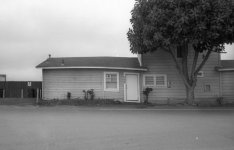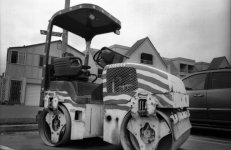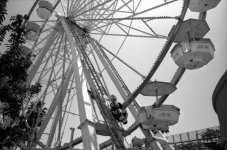sparrow6224
Well-known
I love that grain processing structure or whatever it is - a fine image.
1. When you learn a bit about Photoshop many problems will be solved.
2. I saw 16/30 and thought, eh? The camera is large and while it's a rangefinder it's still a big piece of equipment and you might be getting some camera shake at slow shutter speeds. If so, use 400 film and high shutter speeds or -- drumroll -- a tripod. Or monopod.
3. I have a V600 and got some pretty bad scans from it (also using vuescan) and so bought an aftermarket heavy duty holder and glass -- I can't remember the outfit that sells them but they / he have been discussed on this site so a broad internet search (search function here isn't easy to nail) should find the info. Vast improvement. The advice to buy a piece of glass accomplishes half this solution if it's high enough quality glass. The stuff this guy sells is very well made. If you really can't find it PM me here and I'll search my records for it.
5. Our member Chris Crawford has a fabulously good website in which he offers all kinds of tried and true advice about developing, scanning, and post-processing. Definitely turn off ICE. -- It doesn't work with b/w and in fact is probably blurring edges and elements in the photo since small white looks like dust. Anyway Chris has taught me much. If you find the site helpful consider making a donation as he's a struggling pro out in Indiana where Conde Nast is definitely not calling. One thing, modest or even low contrast negs are better than too contrasty ones, because post processing is very good at adding contrast but not as good at taking it away. Check out Chris' site.
Carry on. Great work.
1. When you learn a bit about Photoshop many problems will be solved.
2. I saw 16/30 and thought, eh? The camera is large and while it's a rangefinder it's still a big piece of equipment and you might be getting some camera shake at slow shutter speeds. If so, use 400 film and high shutter speeds or -- drumroll -- a tripod. Or monopod.
3. I have a V600 and got some pretty bad scans from it (also using vuescan) and so bought an aftermarket heavy duty holder and glass -- I can't remember the outfit that sells them but they / he have been discussed on this site so a broad internet search (search function here isn't easy to nail) should find the info. Vast improvement. The advice to buy a piece of glass accomplishes half this solution if it's high enough quality glass. The stuff this guy sells is very well made. If you really can't find it PM me here and I'll search my records for it.
5. Our member Chris Crawford has a fabulously good website in which he offers all kinds of tried and true advice about developing, scanning, and post-processing. Definitely turn off ICE. -- It doesn't work with b/w and in fact is probably blurring edges and elements in the photo since small white looks like dust. Anyway Chris has taught me much. If you find the site helpful consider making a donation as he's a struggling pro out in Indiana where Conde Nast is definitely not calling. One thing, modest or even low contrast negs are better than too contrasty ones, because post processing is very good at adding contrast but not as good at taking it away. Check out Chris' site.
Carry on. Great work.






